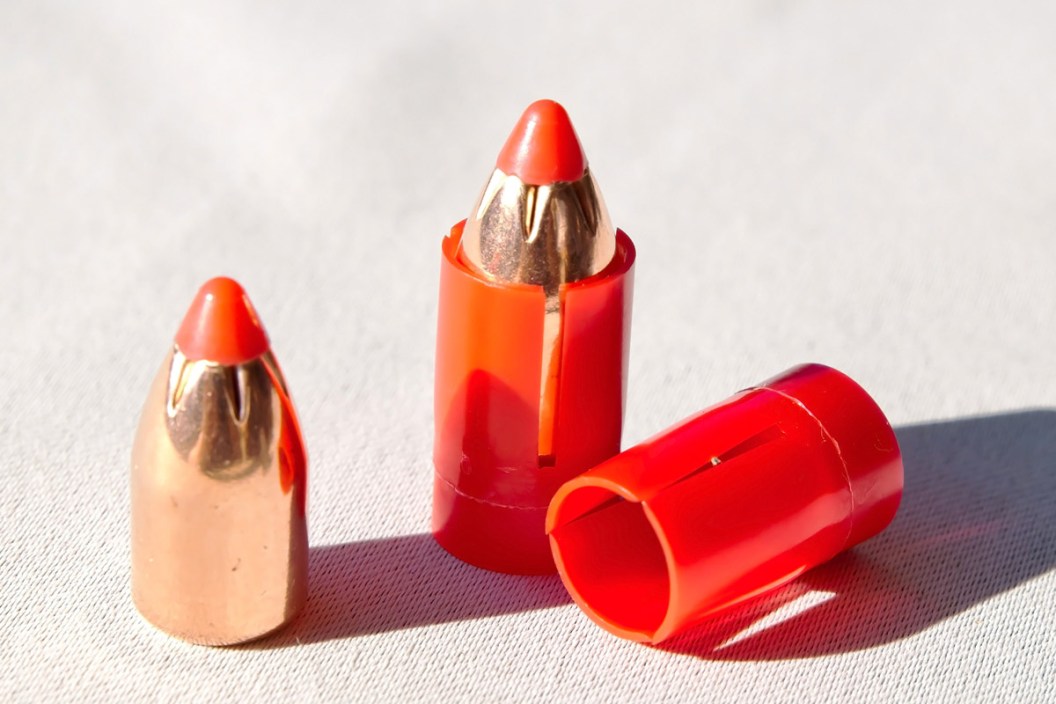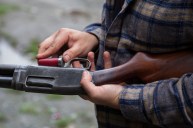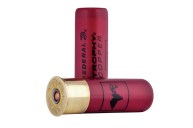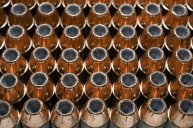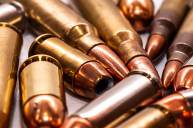Here are the major types of muzzleloader bullets and how they work.
There's a wide array of different muzzleloaders and black powder guns out there, and there are few major categories of projectiles to choose from. Some work best with specific types of muzzleloaders, and each has its own advantages.
Generally, modern in-line muzzleloaders, like those made by Thompson Center, have a faster rifling than those of years past, and consequently work better with modern powerbelt and saboted bullets. Older guns or traditional replicas with slower rifling twist rates work best with lead conical bullets or patched round ball ammo.
Here's a quick guide to the types of muzzleloader bullets for in-line, modern muzzleloaders.
Patched Lead Round Balls
This was the first muzzleloading bullet ever used and somewhat standardized. A projectile has to do a few things in this kind of firearm. It has to form a seal in the bore so that all the pressure of the powder charge igniting is imparted to the projectile, it has to catch the rifling of the bore so that it spins when exiting the muzzle and the user has to be able to force it down the barrel.
A pure lead ball is wrapped in a cloth patch, usually cotton, and then forced down the barrel from the muzzle end. The patch compresses between the ball and the bore, creating the gas seal.
The big benefit of this type of ammunition was that it could be made with a simple bullet mold, some lead and a campfire—and cloth patches could be torn from most anything. Muzzleloaders of the day were typically issued and sold with perfectly matching bullet molds.
These are a pretty tight fit with the patch in a rifled barrel and usually need a bullet starter to get them into the muzzle before switching to the ramrod.
EXAMPLES: Hornady Muzzleloader Round Balls
Conical Bullets
These types of bullets have been around since way back in the 1840s when they were called minié balls. They were made for the battlefield and eventually became the standard for accurate muzzleloader rifles.
The bullet is slightly smaller than the bore, making it easy to load. The hollow base allows the bullet to expand when the powder charge is ignited, forming a tight gas seal, increasing the diameter, and catching the rifling of the bore better—all making for a more accurate projectile. The bullets could also be longer and consequently have more mass than a round ball of the same diameter, meaning more velocity and more power.
Today, conical bullets are made of lead, jacketed lead and full copper.
EXAMPLES: Thor Full Bore Conical Bullet, Hornady FPB
Sabot Bullets
Sabot rounds were a huge leap forward in muzzleloader ammunition technology. Before that, conical lead bullets and patched round balls were all there were. Their introduction nearly coincided with another huge leap in muzzleloader tech, the in-line rifle. The plastic sabot (literally means "shoe" in French) encases the lead or jacketed lead bullet and forms a perfect gas seal in the bore. They greatly increased accuracy and expanded the types of bullets, including hollow-points, that could be fired from a muzzleloader.
They did have some drawbacks. Because of the sabot, the bullet inside it has to be a slightly smaller diameter than the bore. For example, a .50-caliber sabot round holds a .45-caliber bullet. Also, the plastic of the sabot melts a little going down the barrel when being shot, and leaves a bit of residue behind in the rifling. Bores should ideally be cleaned between each shot, or they will become very difficult to reload.
EXAMPLES: Barnes Spit Fire TMZ, Barnes Spit Fire T-EZ, Hornady SST (Super Shock Tip), Traditions Smackdown Bleed
Powerbelt Bullets
The powerbelt bullet has all of the advantages of a conical bullet—they fill the bore for a good seal and load easily—along with the advantages of a saboted bullet, namely the great seal and enhanced accuracy.
Instead of a sabot that wraps around nearly the whole bullet, these bullets have a plastic base that attaches to a nub on the bottom of the bullet. This base, or powerbelt, provides the seal in the bore much the same way the sabot does. But, unlike a sabot, it's actually the bullet that expands and catches the rifling, so these leave no plastic residue behind, which means more reloads between cleanings. And with no sabot, you can shoot full-caliber bullets instead of undersized projectiles in a sabot.
EXAMPLES: Powerbelt Aerolite, Powerbelt ELR, Powerbelt Platinum
Today, powerbelt, sabot and even conical bullets can have a ballistic tip (polymer tip), which increases accuracy and decreases bullet deformation until it hits the target.
Today, most big game hunters stick with powerbelts and sabots, but there are plenty of traditionalists who hunt with percussion cap guns loaded with conicals or patch and ball bullets loaded in front of black powder charges.
Products featured on Wide Open Spaces are independently selected by our editors. However, when you buy something through our links, we may earn a commission.
NEXT: NEW GARMIN XERO A1I PRO BOW SIGHT UNVEILED, DOUBLES DOWN ON REVOLUTIONARY TECHNOLOGY
